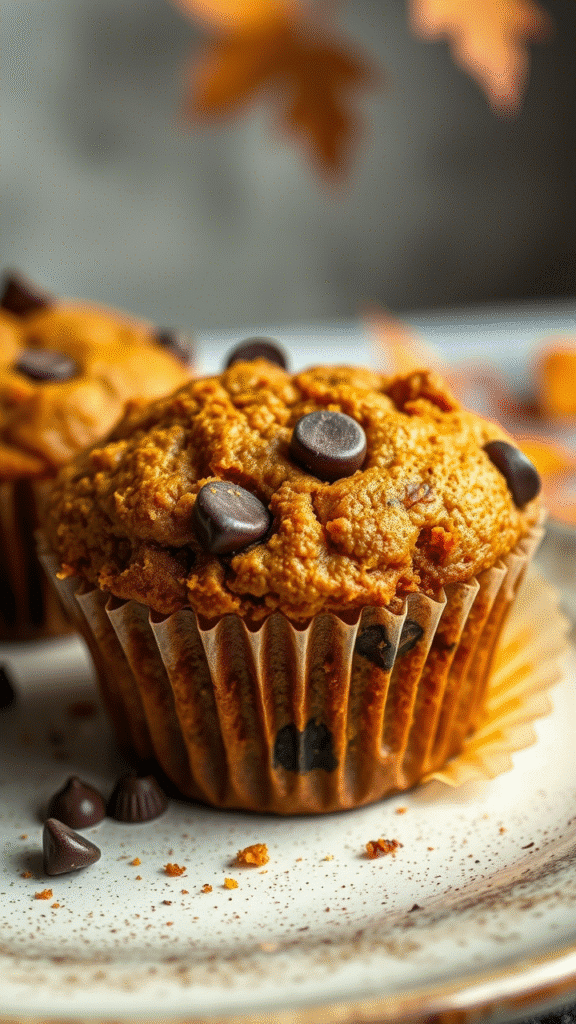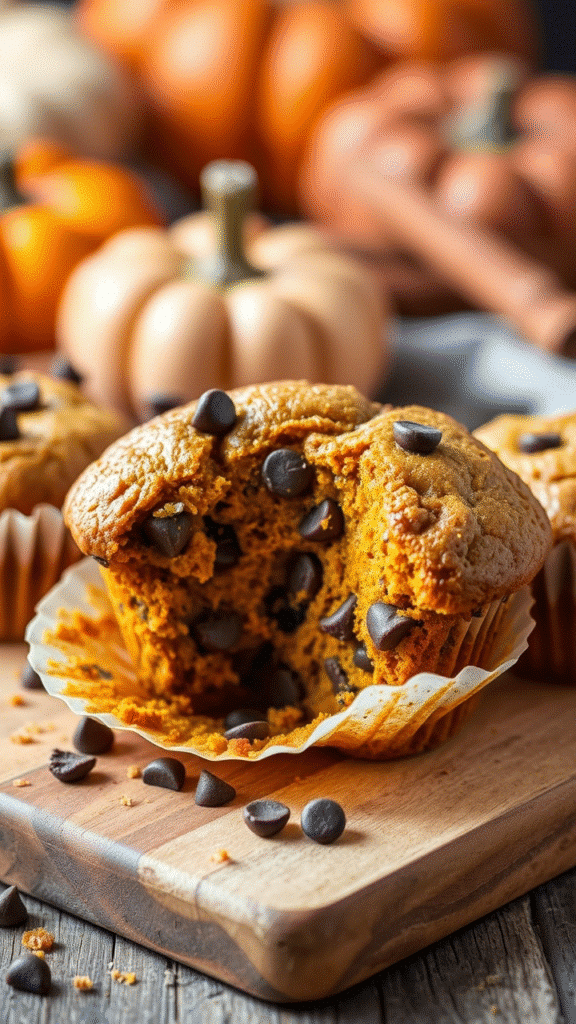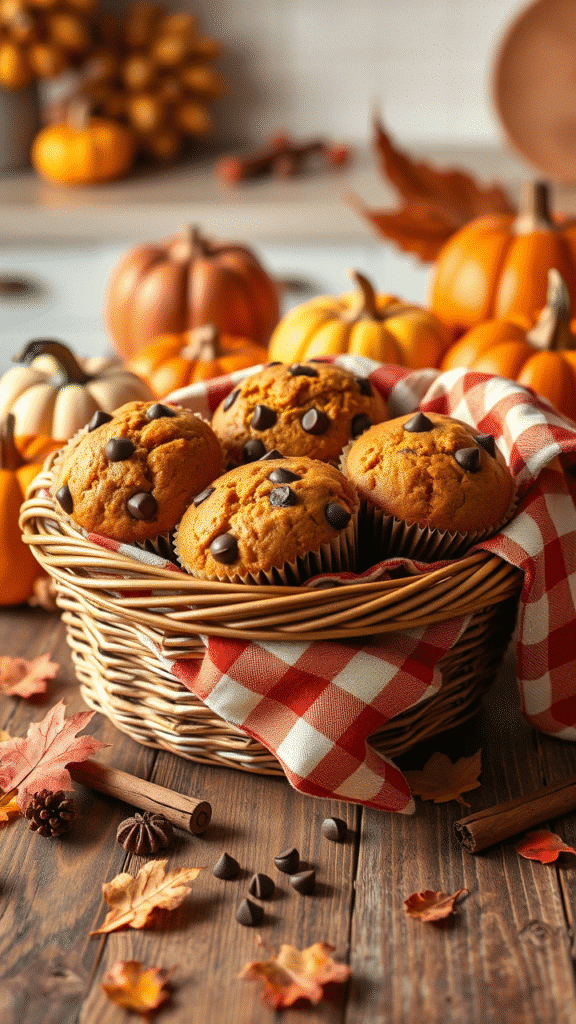I’ll never forget the first time I watched my grandmother’s face light up when she pulled a batch of pumpkin chocolate chip muffins from her ancient gas oven. The kitchen filled with that unmistakable aroma—warm spices dancing with rich cocoa notes. She’d been perfecting this recipe for decades, and watching her work was like witnessing culinary poetry in motion.
There’s something almost magical about how pumpkin and chocolate complement each other. The earthy sweetness of pumpkin creates this incredible backdrop that makes chocolate chips sing rather than dominate. Most bakers think they know muffins, but pumpkin chocolate chip muffins demand a different approach entirely.
What Makes These Muffins Extraordinary
Pumpkin chocolate chip muffins aren’t just another seasonal treat—they’re a masterclass in balancing moisture, flavor, and texture. The pumpkin puree acts as both a flavoring agent and a moisture powerhouse, creating muffins that stay tender for days. Unlike banana bread where the fruit can make things gummy, pumpkin’s fiber structure actually improves the crumb.
The real secret lies in understanding pumpkin’s unique properties. Fresh pumpkin contains more water than canned, which affects your flour ratios dramatically. Canned pumpkin, despite what purists might say, often delivers more consistent results because it’s been concentrated and has standardized moisture content.
Professional bakeries have known this for years—pumpkin muffins require different mixing techniques than standard muffins. The oil integration method works better than the traditional creaming method because pumpkin’s natural enzymes can break down butter’s structure if you’re not careful.
Ingredients & Substitutions
The Foundation Ingredients
For the Dry Mix:
- 2 cups all-purpose flour (or substitute with 1¾ cups all-purpose + ¼ cup almond flour for richness)
- 1 teaspoon baking soda
- ½ teaspoon baking powder
- ½ teaspoon salt
- 1 teaspoon ground cinnamon
- ½ teaspoon ground nutmeg
- ¼ teaspoon ground ginger
- ⅛ teaspoon ground cloves
For the Wet Ingredients:
- 1 cup pumpkin puree (not pumpkin pie filling)
- ½ cup vegetable oil or melted coconut oil
- 2 large eggs, room temperature
- 1¼ cups granulated sugar
- ¼ cup brown sugar, packed
- ¼ cup water or milk
The Star Addition:
- 1 cup semi-sweet chocolate chips (plus extra for topping)
Smart Substitutions for Every Kitchen
Flour flexibility opens up countless possibilities. Bread flour creates chewier muffins—perfect if you prefer substantial texture over tender crumb. Whole wheat pastry flour adds nutty complexity but reduce liquid by 2 tablespoons since it absorbs more moisture.
For those avoiding gluten, a 1:1 gluten-free flour blend works beautifully, though you’ll want to add ¼ teaspoon xanthan gum if your blend doesn’t include it. The pumpkin’s natural binding qualities help gluten-free batters hold together better than most muffin recipes.
Oil substitutions deserve careful consideration. Melted butter creates richer flavor but denser texture. Coconut oil adds subtle tropical notes that pair surprisingly well with warm spices. Greek yogurt can replace half the oil for lighter muffins, though they won’t keep as long.
Sugar adjustments affect more than sweetness—they impact moisture retention and browning. Reducing sugar by ¼ cup creates less sweet muffins that highlight pumpkin’s natural flavor. Brown butter adds incredible depth if you’re willing to take the extra step of browning it first.
Ingredient Quality Makes the Difference
Pumpkin puree quality varies dramatically between brands. Libby’s remains the gold standard because of consistent texture and flavor concentration. Trader Joe’s organic version tends to be more watery, requiring slight flour adjustments.
Spice freshness transforms these muffins from good to extraordinary. Ground spices lose potency after six months, so taste-test your cinnamon before using it. Freshly grated nutmeg provides incomparable warmth that pre-ground versions simply can’t match.
Chocolate chip selection impacts the final product more than most realize. Semi-sweet chips provide balanced sweetness, while dark chocolate chips create sophisticated contrast. Mini chips distribute more evenly throughout the batter, giving every bite chocolate flavor.
Step-by-Step Professional Technique

Preparation: Setting Yourself Up for Success
Preheat your oven to 375°F—not 350°F like most muffin recipes. Pumpkin muffins benefit from higher initial heat that creates better dome structure. Line your muffin tin with paper liners or grease thoroughly with butter and flour. Standard-size muffin tins work best; jumbo muffins often end up undercooked in the center.
Room temperature ingredients mix more evenly and create better emulsification. Take eggs and any dairy out 30 minutes before baking. If you forgot, place eggs in warm water for 5 minutes to bring them up to temperature quickly.
The Mixing Method That Changes Everything
Whisk all dry ingredients together in a large bowl, making sure spices distribute evenly. This step prevents pockets of concentrated spice that can create bitter spots in finished muffins.
In a separate bowl, whisk pumpkin puree until smooth—this eliminates any lumps that could create dense spots. Add oil, eggs, both sugars, and water, whisking until completely combined. The mixture should look glossy and uniform.
Here’s where most home bakers go wrong: they overmix. Pour wet ingredients into dry ingredients and fold gently with a rubber spatula just until flour disappears. The batter should look slightly lumpy—smooth batter means tough muffins.
Fold in chocolate chips with just 3-4 gentle strokes. Overmixing at this stage can cause chips to sink to the bottom during baking.
The Professional Baking Technique
Fill muffin cups about ¾ full—slightly more than standard muffins because pumpkin batter doesn’t rise as dramatically. Sprinkle a few extra chocolate chips on top of each muffin for bakery-style appearance.
Bake at 375°F for 18-22 minutes, rotating the pan halfway through for even browning. The higher temperature creates that desirable domed top while keeping interiors moist.
Test doneness with a toothpick inserted into the center—it should come out with just a few moist crumbs. Completely clean toothpicks usually mean overbaked muffins.
Cooling: The Often-Overlooked Final Step
Let muffins cool in the pan for 5 minutes before transferring to a wire rack. This brief cooling prevents bottoms from becoming soggy while allowing structure to set properly.
The Science Behind Perfect Pumpkin Muffins
Understanding why these techniques work elevates your baking from good to professional level. Pumpkin’s high moisture content requires careful balancing—too much liquid creates gummy texture, while too little results in dry, crumbly muffins.

The combination of baking soda and baking powder creates optimal lift. Baking soda reacts with pumpkin’s natural acidity, while baking powder provides additional lift during the baking process. This double-leavening system compensates for pumpkin’s density.
Higher baking temperature serves multiple purposes. It creates steam quickly, helping muffins rise before proteins set. The rapid heat also caramelizes sugars on the surface, creating that appealing golden-brown color and slightly crisp top.
Oil versus butter choice affects texture significantly. Oil creates more tender muffins because it doesn’t contain water that can develop gluten. However, butter provides superior flavor complexity through milk solids that brown during baking.
Tool Selection Impact
Standard muffin tins produce better results than non-stick versions for pumpkin muffins. The darker surface of standard tins promotes better browning, while non-stick surfaces can cause uneven coloring.
Paper liners versus greasing affects final texture. Liners create slightly steamed sides, while greased tins allow better browning all around. For maximum flavor development, greasing wins every time.
Serving & Pairing Excellence
Fresh from the oven, these muffins pair beautifully with salted butter or cream cheese for breakfast indulgence. The warm spices complement coffee’s bitterness perfectly, creating a harmonious morning experience.
For afternoon treats, serve alongside spiced tea or hot chocolate. The pumpkin’s earthiness balances sweet beverages without competing for attention.
Creative presentation elevates simple muffins into special occasion treats. Dust with powdered sugar just before serving, or drizzle with simple glaze made from powdered sugar and milk.
Storage and Make-Ahead Strategies
Properly stored pumpkin chocolate chip muffins maintain quality for up to five days at room temperature. Store in airtight containers with paper towels to absorb excess moisture—this prevents soggy bottoms.
For longer storage, wrap individual muffins in plastic wrap and freeze for up to three months. Thaw at room temperature or microwave for 20-30 seconds for warm, fresh-tasting muffins.
Batter can be prepared the night before and refrigerated. Cold batter actually produces slightly better texture because flour hydrates more completely overnight.
Advanced Variations and Troubleshooting

Flavor Variations That Work
Espresso powder adds sophisticated depth—just 1 teaspoon transforms these into mocha-pumpkin muffins. Orange zest brightens the overall flavor profile, while maple extract creates autumn comfort food perfection.
Nuts integrate beautifully with this base recipe. Toasted pecans or walnuts add textural contrast and complementary flavors. Toast nuts before adding to develop their full flavor potential.
For adults-only versions, a tablespoon of bourbon or rum creates sophisticated complexity that pairs exceptionally well with the warm spice blend.
Common Problems and Solutions
Dense, heavy muffins usually result from overmixing or using too much flour. Measure flour by weight (4.5 ounces per cup) rather than volume for consistent results.
Sinking chocolate chips indicate either overmixing or chips that are too large. Toss chips in a light coating of flour before folding into batter—this helps them stay suspended.
Flat-topped muffins suggest oven temperature that’s too low or old leavening agents. Replace baking powder every six months and baking soda annually for optimal results.
Dry muffins often result from overbaking or insufficient fat content. Check oven temperature with a thermometer—many home ovens run hot or cold.
The Final Word on Pumpkin Perfection
Mastering pumpkin chocolate chip muffins requires understanding that pumpkin isn’t just another add-in—it’s a primary ingredient that changes everything about traditional muffin technique. The moisture it provides, the density it adds, and the flavors it contributes all demand adjustments to standard methods.
Professional bakers know that consistency comes from understanding ingredients rather than just following recipes. Pumpkin varies seasonally and between brands, so developing your palate and adjusting accordingly separates good bakers from great ones.
These muffins represent autumn comfort food at its finest—warm spices, rich chocolate, and that unmistakable pumpkin flavor that signals the season’s arrival. Master this recipe, and you’ll have a skill that brings joy to every fall gathering.
The key lies in respecting each ingredient’s contribution while understanding how they work together. Pumpkin and chocolate weren’t meant to compete—they were meant to complement, creating something greater than the sum of their parts.
Frequently Asked Questions?
Q: Can I use fresh pumpkin instead of canned pumpkin puree?
Fresh pumpkin absolutely works, but requires extra preparation steps. Roast pumpkin chunks at 400°F until tender, then puree until smooth. Fresh pumpkin contains more water than canned, so reduce liquid ingredients by 2-3 tablespoons. Sugar pie pumpkins work better than carving pumpkins because they’re less watery and more flavorful. Drain fresh puree in a fine-mesh strainer for 30 minutes before using to remove excess moisture.
Q: Why do my muffins sometimes have a green tint?
Green tinting occurs when baking soda reacts with natural compounds in pumpkin, especially if your baking soda is old or you’ve used too much. Stick to the exact amount specified and ensure your baking soda is fresh. Adding a small amount of acid (like lemon juice or cream of tartar) can neutralize this reaction. Some pumpkin varieties naturally contain more of these compounds, so switching brands might solve the problem.
Q: How can I make these muffins healthier without sacrificing taste?
Replace half the oil with unsweetened applesauce or Greek yogurt for reduced fat content. Substitute whole wheat pastry flour for up to half the all-purpose flour—this adds fiber without compromising texture. Reduce sugar by ¼ cup and add extra cinnamon for perceived sweetness. Dark chocolate chips contain more antioxidants than milk chocolate versions. These modifications may slightly reduce shelf life but create more nutritious muffins.
Q: What’s the best way to prevent chocolate chips from sinking?
Toss chocolate chips in a tablespoon of flour before folding into batter—this coating helps them stay suspended during baking. Use mini chocolate chips instead of regular size, as they’re lighter and distribute more evenly. Don’t overmix after adding chips, as this breaks down the flour coating. Slightly thicker batter also helps support chips better, so avoid adding extra liquid unless absolutely necessary.
Q: Can I double this recipe successfully?
Doubling works perfectly, but mix ingredients in batches rather than one huge bowl. Large batches are harder to mix evenly, leading to inconsistent results. Use two separate bowls for wet and dry ingredients, then combine in portions. Bake in multiple batches rather than overcrowding your oven, as this ensures even heat circulation. Double-batch batter can sit at room temperature for up to 30 minutes without affecting quality, so don’t rush the baking process.

Veronica is a passionate food enthusiast with over three years of experience in exploring and writing about diverse cuisines. Her expertise lies in reviewing restaurants, sharing creative recipes, and discovering the latest food trends. As the voice behind FoodieRecap.com, Anju brings fresh perspectives and culinary insights to her audience.
